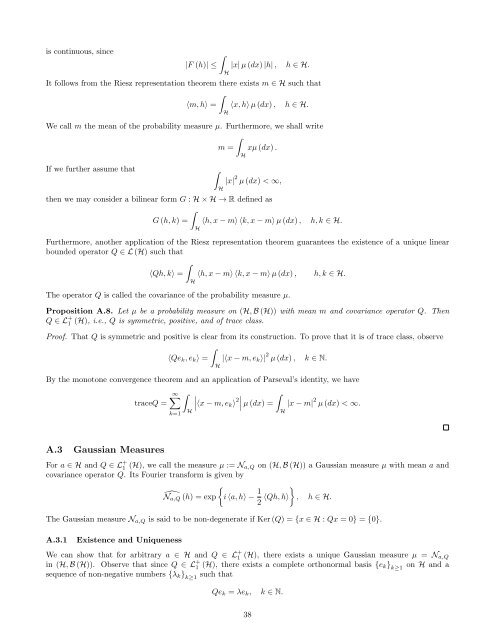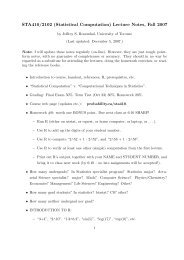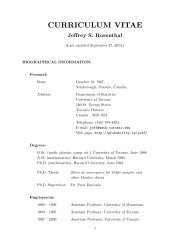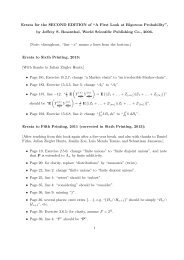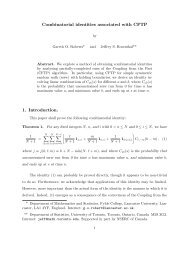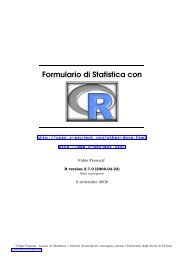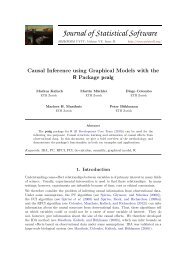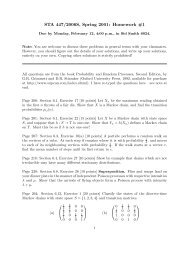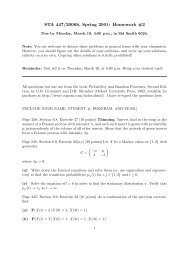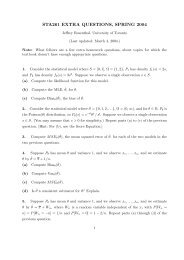final report - probability.ca
final report - probability.ca
final report - probability.ca
You also want an ePaper? Increase the reach of your titles
YUMPU automatically turns print PDFs into web optimized ePapers that Google loves.
is continuous, since<br />
ˆ<br />
|F (h)| ≤<br />
H<br />
|x| µ (dx) |h| , h ∈ H.<br />
It follows from the Riesz representation theorem there exists m ∈ H such that<br />
ˆ<br />
〈m, h〉 = 〈x, h〉 µ (dx) , h ∈ H.<br />
We <strong>ca</strong>ll m the mean of the <strong>probability</strong> measure µ. Furthermore, we shall write<br />
ˆ<br />
m = xµ (dx) .<br />
If we further assume that<br />
ˆ<br />
H<br />
H<br />
H<br />
|x| 2 µ (dx) < ∞,<br />
then we may consider a bilinear form G : H × H → R defined as<br />
ˆ<br />
G (h, k) = 〈h, x − m〉 〈k, x − m〉 µ (dx) , h, k ∈ H.<br />
H<br />
Furthermore, another appli<strong>ca</strong>tion of the Riesz representation theorem guarantees the existence of a unique linear<br />
bounded operator Q ∈ L (H) such that<br />
ˆ<br />
〈Qh, k〉 = 〈h, x − m〉 〈k, x − m〉 µ (dx) , h, k ∈ H.<br />
The operator Q is <strong>ca</strong>lled the covariance of the <strong>probability</strong> measure µ.<br />
H<br />
Proposition A.8. Let µ be a <strong>probability</strong> measure on (H, B (H)) with mean m and covariance operator Q. Then<br />
Q ∈ L + 1 (H), i.e., Q is symmetric, positive, and of trace class.<br />
Proof. That Q is symmetric and positive is clear from its construction. To prove that it is of trace class, observe<br />
ˆ<br />
〈Qe k , e k 〉 = |〈x − m, e k 〉| 2 µ (dx) , k ∈ N.<br />
By the monotone convergence theorem and an appli<strong>ca</strong>tion of Parseval’s identity, we have<br />
traceQ =<br />
∞∑<br />
ˆ<br />
k=1<br />
H<br />
H<br />
∣<br />
∣〈x − m, e k 〉 2∣ ˆ<br />
∣ µ (dx) =<br />
H<br />
|x − m| 2 µ (dx) < ∞.<br />
A.3 Gaussian Measures<br />
For a ∈ H and Q ∈ L + 1 (H), we <strong>ca</strong>ll the measure µ := N a,Q on (H, B (H)) a Gaussian measure µ with mean a and<br />
covariance operator Q. Its Fourier transform is given by<br />
̂N a,Q (h) = exp<br />
{i 〈a, h〉 − 1 }<br />
2 〈Qh, h〉 , h ∈ H.<br />
The Gaussian measure N a,Q is said to be non-degenerate if Ker (Q) = {x ∈ H : Qx = 0} = {0}.<br />
A.3.1<br />
Existence and Uniqueness<br />
We <strong>ca</strong>n show that for arbitrary a ∈ H and Q ∈ L + 1 (H), there exists a unique Gaussian measure µ = N a,Q<br />
in (H, B (H)). Observe that since Q ∈ L + 1 (H), there exists a complete orthonormal basis {e k} k≥1<br />
on H and a<br />
sequence of non-negative numbers {λ k } k≥1<br />
such that<br />
Qe k = λe k , k ∈ N.<br />
38


